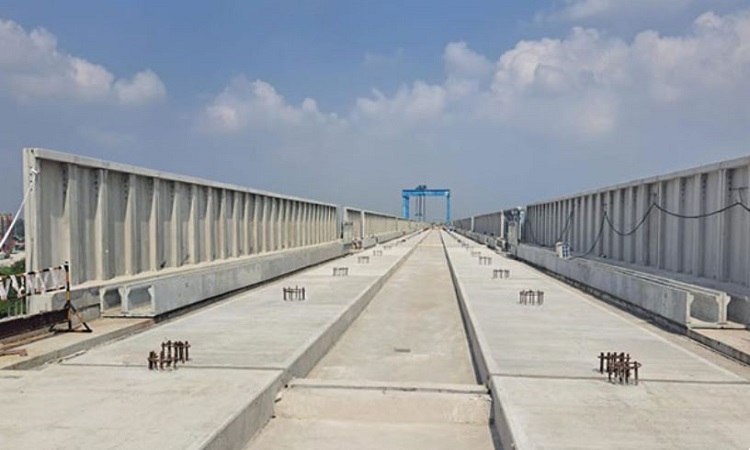First reinforced concrete track bed construction begins for Mumbai-Ahmedabad High-Speed Rail Corridor in Surat
In a significant milestone for the Mumbai-Ahmedabad High-Speed Rail Corridor project, the construction of the first Reinforced Concrete (RC) track bed commenced in Surat. Read further on Dynamite News:

Surat: In a significant milestone for the Mumbai-Ahmedabad High-Speed Rail Corridor project, the construction of the first Reinforced Concrete (RC) track bed commenced in Surat.
The project marks the debut of the J-slab ballastless track system in India, akin to the acclaimed Japanese Shinkansen.
Talking to ANI about this project, H. L. Suthar, Principal Executive Director, Track and Design of NHSRCL, said that the innovative track system incorporates pre-cast track slabs, fastening devices, and rails atop the RC track bed, which is constructed in-situ at a thickness of approximately 300mm for each individual UP and Down track line on the viaduct top.
The RC track bed's width measures 2420 mm and it features RC anchors at 5-meter intervals to prevent longitudinal and lateral restraints on the track slab.
Suthar further informed that the RC anchors, with a diameter of 520 mm and a height of 260 mm, facilitate precise alignment, both horizontally and vertically, ensuring seamless train operations at speeds of up to 320 Kmph.
"Contracts for track works in the entire Gujarat portion have been awarded, and material procurement for track works is well underway. Over 14000 MT of JIS rails and 50 moulds for casting track slabs have already been received from Japan", he added.
It is notable that dedicated factories, equipped with state-of-the-art technology, have been established to manufacture track slabs meeting the stringent standards required for HSR track construction.
Further, specialised construction machinery, including rail feeder cars, slab laying cars, and CAM (Cement Asphalt Mortar) laying cars, will be employed for track works. To ensure the efficient execution of track laying operations, extensive training and certification programs for Indian contractor personnel are being conducted in collaboration with Japan Railway Technical Services (JARTS).
It is pertinent to note that spanning across 508 kilometres, the Mumbai - Ahmedabad High-Speed Rail corridor will offer fast connectivity between the two financial hubs located in the states of Maharashtra and Gujarat in western India.
After starting from Mumbai's Bandra Kurla Complex (BKC) area, the high-speed train running at a speed of 320 km/h will revolutionise intercity travel in the region. It will have stops at 10 cities in between namely Thane, Virar, Boisar, Vapi, Bilimora, Surat, Bharuch, Vadodara, Anand, and Ahmedabad and will terminate at Sabarmati.
The entire journey will be completed in about two hours and seven minutes with limited stops (at Surat, Vadodara and Ahmedabad), which is substantially less than the time taken by conventional trains or road journeys.
National High-Speed Rail Corporation Limited (NHSRCL) was incorporated on 12th February 2016 under the Companies Act, 2013 with the object of financing, constructing, maintaining and managing the High-Speed Rail Corridor in India.
The Company has been modelled as a 'Special Purpose Vehicle' in the joint sector with equity participation by the Central Government through the Ministry of Railways and two State Governments viz. Government of Gujarat and Government of Maharashtra. (ANI)
 Dynamite News
Dynamite News